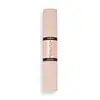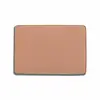Revolution Beauty Fast Base Contour Stick Versus KVD Vegan Beauty Shade + Light Powder Contour Palette Refill Pan
What's inside
What's inside
 Key Ingredients
Key Ingredients

 Benefits
Benefits

No benefits
 Concerns
Concerns

 Ingredients Side-by-side
Ingredients Side-by-side

Mica
Cosmetic ColorantEthylhexyl Palmitate
EmollientTriethylhexanoin
MaskingCera Microcristallina
Emulsion StabilisingSilica
AbrasiveSorbitan Isostearate
EmulsifyingDimethicone/Vinyl Dimethicone Crosspolymer
Skin ConditioningPolyethylene
AbrasiveBis-Diglyceryl Polyacyladipate-1
EmollientDicalcium Phosphate Dihydrate
AbrasiveTriethoxycaprylylsilane
Tocopheryl Acetate
AntioxidantPropylparaben
PreservativeBHT
AntioxidantCI 77891
Cosmetic ColorantCI 77491
Cosmetic ColorantCI 77492
Cosmetic ColorantCI 77499
Cosmetic ColorantMica, Ethylhexyl Palmitate, Triethylhexanoin, Cera Microcristallina, Silica, Sorbitan Isostearate, Dimethicone/Vinyl Dimethicone Crosspolymer, Polyethylene, Bis-Diglyceryl Polyacyladipate-1, Dicalcium Phosphate Dihydrate, Triethoxycaprylylsilane, Tocopheryl Acetate, Propylparaben, BHT, CI 77891, CI 77491, CI 77492, CI 77499
Mica
Cosmetic ColorantZinc Stearate
Cosmetic ColorantSilica
AbrasiveSqualane
EmollientPolyethylene
AbrasiveEthylhexyl Palmitate
EmollientDimethicone
EmollientGlyceryl Caprylate
EmollientLauroyl Lysine
Skin ConditioningSodium Dehydroacetate
PreservativePotassium Sorbate
PreservativeTocopheryl Acetate
AntioxidantCarthamus Tinctorius Seed Oil
MaskingRosa Canina Flower Extract
AstringentWater
Skin ConditioningSodium Sulfate
CI 77891
Cosmetic ColorantIron Oxides
CI 77007
Cosmetic ColorantCI 77742
Cosmetic ColorantMica, Zinc Stearate, Silica, Squalane, Polyethylene, Ethylhexyl Palmitate, Dimethicone, Glyceryl Caprylate, Lauroyl Lysine, Sodium Dehydroacetate, Potassium Sorbate, Tocopheryl Acetate, Carthamus Tinctorius Seed Oil, Rosa Canina Flower Extract, Water, Sodium Sulfate, CI 77891, Iron Oxides, CI 77007, CI 77742
Ingredients Explained
These ingredients are found in both products.
Ingredients higher up in an ingredient list are typically present in a larger amount.
Ci 77891 is a white pigment from Titanium dioxide. It is naturally found in minerals such as rutile and ilmenite.
It's main function is to add a white color to cosmetics. It can also be mixed with other colors to create different shades.
Ci 77891 is commonly found in sunscreens due to its ability to block UV rays.
Learn more about CI 77891Ethylhexyl Palmitate, also known as octyl palmitate, is created from 2-ethylhexyl alcohol and palmitic acid. It is a fatty acid ester.
The fatty acid content of Ethylhexyl Palmitate makes it an emollient. Emollients help soften and hydrate your skin by trapping moisture within.
Ethylhexyl Palmitate is also used to help improve the texture of cosmetics. It helps other ingredient dissolve in products and help disperse ingredients more evenly.
You'll likely find this ingredient in sunscreen, as it is often used to mix UV-blocking ingredients such as avobenzone and ethylhexyl triazone.
It can also help stabilize the fragrances in a product as a fragrance fixative.
Ethylhexyl Palmitate can be used to substitute mineral oil.
Due to its high fatty acid content, it may not be fungal-acne safe.
Learn more about Ethylhexyl PalmitateMica is a naturally occurring mineral used to add shimmer and color in cosmetics. It can also help improve the texture of a product or give it an opaque, white/silver color.
Serecite is the name for very fine but ragged grains of mica.
This ingredient is often coated with metal oxides like titanium dioxide. Trace amounts of heavy metals may be found in mica, but these metals are not harmful in our personal products.
Mica has been used since prehistoric times throughout the world. Ancient Egyptian, Indian, Greek, Roman, Aztec, and Chinese civilizations have used mica.
Learn more about MicaPolyethylene is a synthetic ingredient that helps the skin retain moisture. It is a polymer.
It is also typically used within product formulations to help bind solid ingredients together and thicken oil-based ingredients. When added to balms and emulsions, it helps increase the melting point temperature.
Silica, also known as silicon dioxide, is a naturally occurring mineral. It is used as a fine, spherical, and porous powder in cosmetics.
Though it has exfoliant properties, the function of silica varies depending on the product.
The unique structure of silica enhances the spreadability and adds smoothness, making it a great texture enhancer.
It is also used as an active carrier, emulsifier, and mattifier due to its ability to absorb excess oil.
In some products, tiny microneedles called spicules are made from silica or hydrolyzed sponge. When you rub them in, they lightly polish away dead skin layers and enhance the penetration of active ingredients.
Learn more about SilicaTocopheryl Acetate is AKA Vitamin E. It is an antioxidant and protects your skin from free radicals. Free radicals damage the skin by breaking down collagen.
One study found using Tocopheryl Acetate with Vitamin C decreased the number of sunburned cells.
Tocopheryl Acetate is commonly found in both skincare and dietary supplements.
Learn more about Tocopheryl Acetate